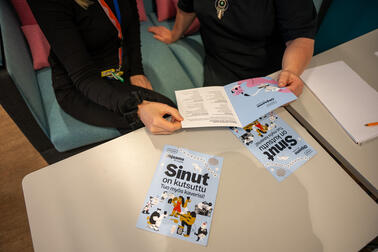
When a young person becomes involved with the police, it does not tend to result in jail or a fine. The police aim to help young people through extensive cooperation with other youth work professionals. "The most important things is to achieve trust and dialogue," says Chief Inspector Katja Nissinen.
According to Chief Inspector Katja Nissinen from the Preventive Policing Unit at the Helsinki Police Department, it is a joy to meet young people through work.
When there is talk of safety in cities, the behaviour of young people is always part of that discussion. The way in which young people tend to hang out in groups in central locations, push boundaries and at times, do silly things makes them into an easy target for criticism and comments.
"Often the problem is disorderly conduct and shouting that increase the feeling of insecurity. And then there is the small group of youngsters who abuse substances and commit crimes. Young people's problems are not uniform; the majority of them are doing well, and then there are those few who are really deprived," summarises Chief Inspector Katja Nissinen from the Preventive Policing Unit at the Helsinki Police Department.
When a young person then ends up involved with the police, the assumption tends to be that they will face jail or fines.
"This is of course not the case. Naturally if you commit a crime, you carry the responsibility, but we operate in many different ways these days. Dialogue is the key. For example, if we see a young person spending time with a drug dealer, we may invite the young person and the parents in for a conversation. The aim of the meeting is to find out if there are bigger underlying problems and to try to find the right kind of help. The goal of the process is to support the young person and the family and not to punish," Nissinen tells.
Cooperation with other authorities and actors is important in police work.
“The entire process of providing help involves professionals from different sectors, and with our cooperation partners, we have hundreds of eyes on the streets at all times," Nissinen describes.
From the perspective of youth work, it is also important that the police respect the other professionals' role, approaches and objectives.
"For instance, social workers have strict confidentiality requirements. They are respected, as are the problem-solving methods and responsibilities of all authorities," Nissinen says.
Police's anchor activities help entire families
One of the sections of the Preventive Policing Unit within the Helsinki Police Department is the anchor work for young people who have become involved with criminal activities. At the anchor, young people are met by a multi-professional team, which includes a psychiatric nurse and a social worker, in addition to the police. The team has a shared group work room at the police premises.
"We choose our customers, and often they end up taking part in the anchor activities through the police or other interest groups. The young people have diverse backgrounds and come from both well-off and disadvantaged families. The problems might be caused by fatigue in the family, domestic violence, multigenerational alienation or mental health problems. Although, not always of course," tells Chief Inspector Katja Nissinen.
One of the important objectives of anchor work is to ensure that every meeting ends with some kind of an action plan.
"Frequent meetings which do not lead to any actual conclusions are a challenge in our society. Offering correctly timed help for young people means fast actions. You cannot leave anyone waiting for a decision for half a year. Therefore, we have professionals from different sectors in attendance, and those decisions can be made there and then," Nissinen remarks.
In addition to the young person in question, the whole family tends to be involved in the anchor work.
"Sometimes parents have lost their way, and if that's the case, we provide help to them too. We try to find solutions for everyone, but the young person is always at the centre. These issues are never simple, and our first goal is always to try and ensure that the young person could stay at home with their family. Unfortunately, at times some other place may be better for the youngster.”
Polarisation of debate does not solve problems
According to Chief Inspector Nissinen, young people in Helsinki are on average well behaved and pleasant.
"They want to be part of achieving a better city, and it is a joy to meet them at work every day. Young people are keen to ask for advice and genuinely take care of their friends' problems as well. It is great that they trust the police and that we can take things forward together. It might be part of the reason why crimes committed by young people have been steadily declining in recent years.”
Communication is also important for maintaining the general feeling of safety. If that is unsuccessful, young people often get the blame and the feeling of insecurity increases. Nissinen regrets the polarisation of the discussion.
"Often the public debate depicts young people against the old or native Finns against immigrants. We need more honest discussions about the underlying problems young people are dealing with. Afterall, a young immigrant in Helsinki tends to have exactly the same problems as their peer in Kuopio," Nissinen reminds.
Of course, there is a group of young people who are battling major challenges due to significant deprivation.
"Some of those problems are societal and some specific to the individual. However, here in Helsinki we do a lot of work to solve the root problems of young people. Together, we try and do better and more all the time," Nissinen sums up.
Iframe not supported
The article is part of the Nordic Safe Cities alliance's Safe City Tour.
Nordic Safe Cities(Link leads to external service)
(NSC), established by the Nordic Council of Ministers in 2016, is a non-profit network focusing on safety in the Nordic countries. The NSC activities aim to have a positive impact on safety in cities and to stand against polarisation and violent extremism. Helsinki has participated in the network's activities from the start.
Text: Vilja Roihu / Stooritaivas Oy
Images: Aki Rahikka / Stooritaivas Oy


